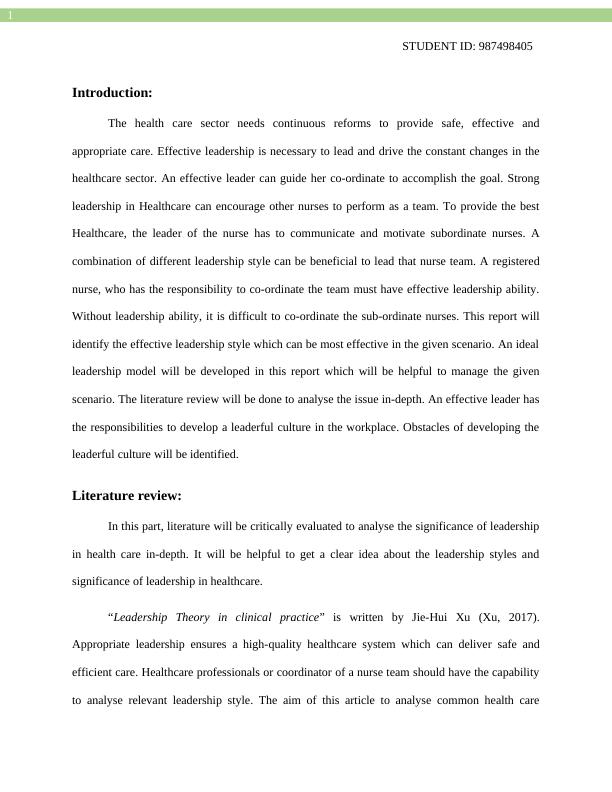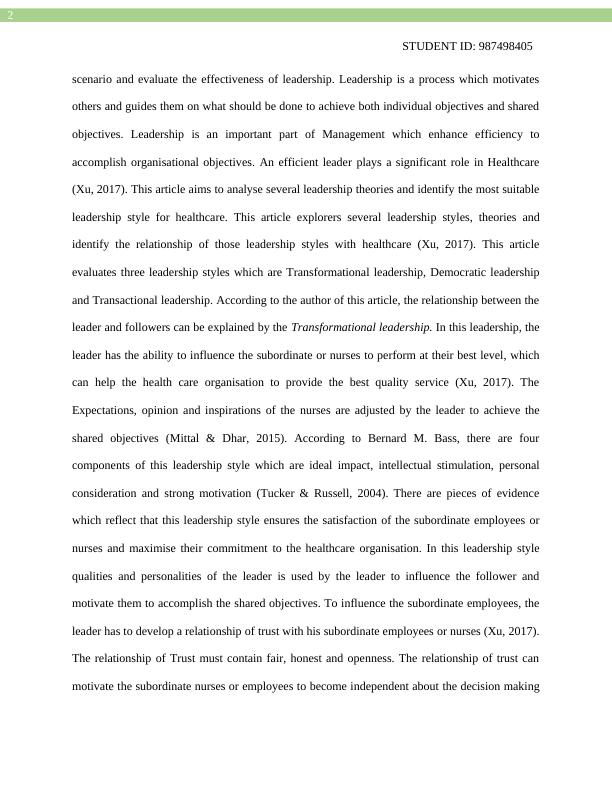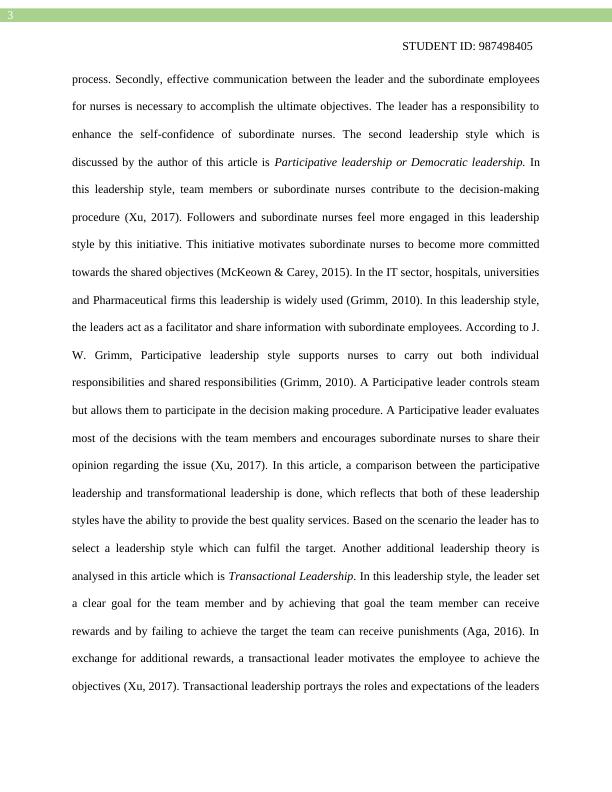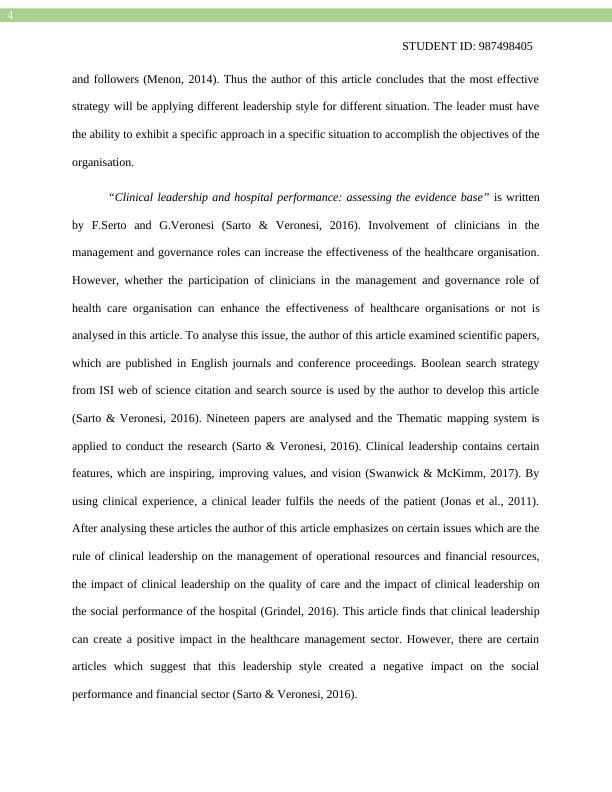Health Care Sector And Reforms Analysis Report
Added on 2022-08-18
14 Pages4865 Words15 Views
STUDENT ID: 987498405
1
Introduction:
The health care sector needs continuous reforms to provide safe, effective and
appropriate care. Effective leadership is necessary to lead and drive the constant changes in the
healthcare sector. An effective leader can guide her co-ordinate to accomplish the goal. Strong
leadership in Healthcare can encourage other nurses to perform as a team. To provide the best
Healthcare, the leader of the nurse has to communicate and motivate subordinate nurses. A
combination of different leadership style can be beneficial to lead that nurse team. A registered
nurse, who has the responsibility to co-ordinate the team must have effective leadership ability.
Without leadership ability, it is difficult to co-ordinate the sub-ordinate nurses. This report will
identify the effective leadership style which can be most effective in the given scenario. An ideal
leadership model will be developed in this report which will be helpful to manage the given
scenario. The literature review will be done to analyse the issue in-depth. An effective leader has
the responsibilities to develop a leaderful culture in the workplace. Obstacles of developing the
leaderful culture will be identified.
Literature review:
In this part, literature will be critically evaluated to analyse the significance of leadership
in health care in-depth. It will be helpful to get a clear idea about the leadership styles and
significance of leadership in healthcare.
“Leadership Theory in clinical practice” is written by Jie-Hui Xu (Xu, 2017).
Appropriate leadership ensures a high-quality healthcare system which can deliver safe and
efficient care. Healthcare professionals or coordinator of a nurse team should have the capability
to analyse relevant leadership style. The aim of this article to analyse common health care
1
Introduction:
The health care sector needs continuous reforms to provide safe, effective and
appropriate care. Effective leadership is necessary to lead and drive the constant changes in the
healthcare sector. An effective leader can guide her co-ordinate to accomplish the goal. Strong
leadership in Healthcare can encourage other nurses to perform as a team. To provide the best
Healthcare, the leader of the nurse has to communicate and motivate subordinate nurses. A
combination of different leadership style can be beneficial to lead that nurse team. A registered
nurse, who has the responsibility to co-ordinate the team must have effective leadership ability.
Without leadership ability, it is difficult to co-ordinate the sub-ordinate nurses. This report will
identify the effective leadership style which can be most effective in the given scenario. An ideal
leadership model will be developed in this report which will be helpful to manage the given
scenario. The literature review will be done to analyse the issue in-depth. An effective leader has
the responsibilities to develop a leaderful culture in the workplace. Obstacles of developing the
leaderful culture will be identified.
Literature review:
In this part, literature will be critically evaluated to analyse the significance of leadership
in health care in-depth. It will be helpful to get a clear idea about the leadership styles and
significance of leadership in healthcare.
“Leadership Theory in clinical practice” is written by Jie-Hui Xu (Xu, 2017).
Appropriate leadership ensures a high-quality healthcare system which can deliver safe and
efficient care. Healthcare professionals or coordinator of a nurse team should have the capability
to analyse relevant leadership style. The aim of this article to analyse common health care

STUDENT ID: 987498405
2
scenario and evaluate the effectiveness of leadership. Leadership is a process which motivates
others and guides them on what should be done to achieve both individual objectives and shared
objectives. Leadership is an important part of Management which enhance efficiency to
accomplish organisational objectives. An efficient leader plays a significant role in Healthcare
(Xu, 2017). This article aims to analyse several leadership theories and identify the most suitable
leadership style for healthcare. This article explorers several leadership styles, theories and
identify the relationship of those leadership styles with healthcare (Xu, 2017). This article
evaluates three leadership styles which are Transformational leadership, Democratic leadership
and Transactional leadership. According to the author of this article, the relationship between the
leader and followers can be explained by the Transformational leadership. In this leadership, the
leader has the ability to influence the subordinate or nurses to perform at their best level, which
can help the health care organisation to provide the best quality service (Xu, 2017). The
Expectations, opinion and inspirations of the nurses are adjusted by the leader to achieve the
shared objectives (Mittal & Dhar, 2015). According to Bernard M. Bass, there are four
components of this leadership style which are ideal impact, intellectual stimulation, personal
consideration and strong motivation (Tucker & Russell, 2004). There are pieces of evidence
which reflect that this leadership style ensures the satisfaction of the subordinate employees or
nurses and maximise their commitment to the healthcare organisation. In this leadership style
qualities and personalities of the leader is used by the leader to influence the follower and
motivate them to accomplish the shared objectives. To influence the subordinate employees, the
leader has to develop a relationship of trust with his subordinate employees or nurses (Xu, 2017).
The relationship of Trust must contain fair, honest and openness. The relationship of trust can
motivate the subordinate nurses or employees to become independent about the decision making
2
scenario and evaluate the effectiveness of leadership. Leadership is a process which motivates
others and guides them on what should be done to achieve both individual objectives and shared
objectives. Leadership is an important part of Management which enhance efficiency to
accomplish organisational objectives. An efficient leader plays a significant role in Healthcare
(Xu, 2017). This article aims to analyse several leadership theories and identify the most suitable
leadership style for healthcare. This article explorers several leadership styles, theories and
identify the relationship of those leadership styles with healthcare (Xu, 2017). This article
evaluates three leadership styles which are Transformational leadership, Democratic leadership
and Transactional leadership. According to the author of this article, the relationship between the
leader and followers can be explained by the Transformational leadership. In this leadership, the
leader has the ability to influence the subordinate or nurses to perform at their best level, which
can help the health care organisation to provide the best quality service (Xu, 2017). The
Expectations, opinion and inspirations of the nurses are adjusted by the leader to achieve the
shared objectives (Mittal & Dhar, 2015). According to Bernard M. Bass, there are four
components of this leadership style which are ideal impact, intellectual stimulation, personal
consideration and strong motivation (Tucker & Russell, 2004). There are pieces of evidence
which reflect that this leadership style ensures the satisfaction of the subordinate employees or
nurses and maximise their commitment to the healthcare organisation. In this leadership style
qualities and personalities of the leader is used by the leader to influence the follower and
motivate them to accomplish the shared objectives. To influence the subordinate employees, the
leader has to develop a relationship of trust with his subordinate employees or nurses (Xu, 2017).
The relationship of Trust must contain fair, honest and openness. The relationship of trust can
motivate the subordinate nurses or employees to become independent about the decision making

STUDENT ID: 987498405
3
process. Secondly, effective communication between the leader and the subordinate employees
for nurses is necessary to accomplish the ultimate objectives. The leader has a responsibility to
enhance the self-confidence of subordinate nurses. The second leadership style which is
discussed by the author of this article is Participative leadership or Democratic leadership. In
this leadership style, team members or subordinate nurses contribute to the decision-making
procedure (Xu, 2017). Followers and subordinate nurses feel more engaged in this leadership
style by this initiative. This initiative motivates subordinate nurses to become more committed
towards the shared objectives (McKeown & Carey, 2015). In the IT sector, hospitals, universities
and Pharmaceutical firms this leadership is widely used (Grimm, 2010). In this leadership style,
the leaders act as a facilitator and share information with subordinate employees. According to J.
W. Grimm, Participative leadership style supports nurses to carry out both individual
responsibilities and shared responsibilities (Grimm, 2010). A Participative leader controls steam
but allows them to participate in the decision making procedure. A Participative leader evaluates
most of the decisions with the team members and encourages subordinate nurses to share their
opinion regarding the issue (Xu, 2017). In this article, a comparison between the participative
leadership and transformational leadership is done, which reflects that both of these leadership
styles have the ability to provide the best quality services. Based on the scenario the leader has to
select a leadership style which can fulfil the target. Another additional leadership theory is
analysed in this article which is Transactional Leadership. In this leadership style, the leader set
a clear goal for the team member and by achieving that goal the team member can receive
rewards and by failing to achieve the target the team can receive punishments (Aga, 2016). In
exchange for additional rewards, a transactional leader motivates the employee to achieve the
objectives (Xu, 2017). Transactional leadership portrays the roles and expectations of the leaders
3
process. Secondly, effective communication between the leader and the subordinate employees
for nurses is necessary to accomplish the ultimate objectives. The leader has a responsibility to
enhance the self-confidence of subordinate nurses. The second leadership style which is
discussed by the author of this article is Participative leadership or Democratic leadership. In
this leadership style, team members or subordinate nurses contribute to the decision-making
procedure (Xu, 2017). Followers and subordinate nurses feel more engaged in this leadership
style by this initiative. This initiative motivates subordinate nurses to become more committed
towards the shared objectives (McKeown & Carey, 2015). In the IT sector, hospitals, universities
and Pharmaceutical firms this leadership is widely used (Grimm, 2010). In this leadership style,
the leaders act as a facilitator and share information with subordinate employees. According to J.
W. Grimm, Participative leadership style supports nurses to carry out both individual
responsibilities and shared responsibilities (Grimm, 2010). A Participative leader controls steam
but allows them to participate in the decision making procedure. A Participative leader evaluates
most of the decisions with the team members and encourages subordinate nurses to share their
opinion regarding the issue (Xu, 2017). In this article, a comparison between the participative
leadership and transformational leadership is done, which reflects that both of these leadership
styles have the ability to provide the best quality services. Based on the scenario the leader has to
select a leadership style which can fulfil the target. Another additional leadership theory is
analysed in this article which is Transactional Leadership. In this leadership style, the leader set
a clear goal for the team member and by achieving that goal the team member can receive
rewards and by failing to achieve the target the team can receive punishments (Aga, 2016). In
exchange for additional rewards, a transactional leader motivates the employee to achieve the
objectives (Xu, 2017). Transactional leadership portrays the roles and expectations of the leaders

STUDENT ID: 987498405
4
and followers (Menon, 2014). Thus the author of this article concludes that the most effective
strategy will be applying different leadership style for different situation. The leader must have
the ability to exhibit a specific approach in a specific situation to accomplish the objectives of the
organisation.
“Clinical leadership and hospital performance: assessing the evidence base” is written
by F.Serto and G.Veronesi (Sarto & Veronesi, 2016). Involvement of clinicians in the
management and governance roles can increase the effectiveness of the healthcare organisation.
However, whether the participation of clinicians in the management and governance role of
health care organisation can enhance the effectiveness of healthcare organisations or not is
analysed in this article. To analyse this issue, the author of this article examined scientific papers,
which are published in English journals and conference proceedings. Boolean search strategy
from ISI web of science citation and search source is used by the author to develop this article
(Sarto & Veronesi, 2016). Nineteen papers are analysed and the Thematic mapping system is
applied to conduct the research (Sarto & Veronesi, 2016). Clinical leadership contains certain
features, which are inspiring, improving values, and vision (Swanwick & McKimm, 2017). By
using clinical experience, a clinical leader fulfils the needs of the patient (Jonas et al., 2011).
After analysing these articles the author of this article emphasizes on certain issues which are the
rule of clinical leadership on the management of operational resources and financial resources,
the impact of clinical leadership on the quality of care and the impact of clinical leadership on
the social performance of the hospital (Grindel, 2016). This article finds that clinical leadership
can create a positive impact in the healthcare management sector. However, there are certain
articles which suggest that this leadership style created a negative impact on the social
performance and financial sector (Sarto & Veronesi, 2016).
4
and followers (Menon, 2014). Thus the author of this article concludes that the most effective
strategy will be applying different leadership style for different situation. The leader must have
the ability to exhibit a specific approach in a specific situation to accomplish the objectives of the
organisation.
“Clinical leadership and hospital performance: assessing the evidence base” is written
by F.Serto and G.Veronesi (Sarto & Veronesi, 2016). Involvement of clinicians in the
management and governance roles can increase the effectiveness of the healthcare organisation.
However, whether the participation of clinicians in the management and governance role of
health care organisation can enhance the effectiveness of healthcare organisations or not is
analysed in this article. To analyse this issue, the author of this article examined scientific papers,
which are published in English journals and conference proceedings. Boolean search strategy
from ISI web of science citation and search source is used by the author to develop this article
(Sarto & Veronesi, 2016). Nineteen papers are analysed and the Thematic mapping system is
applied to conduct the research (Sarto & Veronesi, 2016). Clinical leadership contains certain
features, which are inspiring, improving values, and vision (Swanwick & McKimm, 2017). By
using clinical experience, a clinical leader fulfils the needs of the patient (Jonas et al., 2011).
After analysing these articles the author of this article emphasizes on certain issues which are the
rule of clinical leadership on the management of operational resources and financial resources,
the impact of clinical leadership on the quality of care and the impact of clinical leadership on
the social performance of the hospital (Grindel, 2016). This article finds that clinical leadership
can create a positive impact in the healthcare management sector. However, there are certain
articles which suggest that this leadership style created a negative impact on the social
performance and financial sector (Sarto & Veronesi, 2016).

End of preview
Want to access all the pages? Upload your documents or become a member.
Related Documents
ALHLT 3933 - Healthcare Management | Effective Management Assignmentlg...
|13
|3805
|178
Importance of Clinical Leadership in Nursinglg...
|6
|1919
|44
Clinical Leadership and Patient Safetylg...
|8
|2154
|299
Leadership Theory in Clinical Practicelg...
|8
|3756
|68
Importance of Leadership Style towards Quality of Care Measures in Healthcare Settings: A Systematic Reviewlg...
|17
|9111
|169
Importance of Nursing Leadership in Improving Patient Carelg...
|9
|2606
|69
